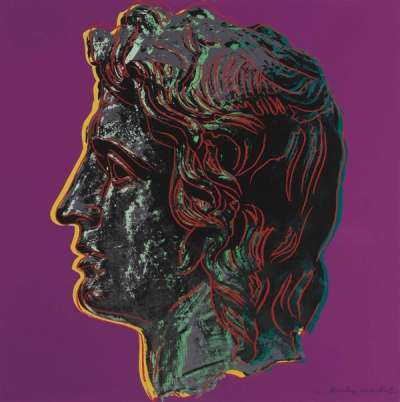Alexander
The Great
While Andy Warhol is better known for portraits of his contemporaries, he also created this print series depicting Alexander the Great in 1983. Commissioned by the MoMA, Warhol’s series also homages art dealer, Alexander Iolas, whose own distinctive Greek features earnt him the moniker ‘the Great’.
Andy Warhol Alexander The Great For sale
Alexander The Great Value (5 Years)
Works from the Alexander The Great series by Andy Warhol have a strong market value presence, with 33 auction appearances. Top performing works have achieved standout auction results, with peak hammer prices of £132999. Over the past 12 months, average values across the series have ranged from £69424 to £110000. The series shows an average annual growth rate of 3.2%.
Alexander The Great Market value
Auction Results
| Artwork | Auction Date | Auction House | Return to Seller | Hammer Price | Buyer Paid |
|---|---|---|---|---|---|
 Alexander The Great (F. & S. II.292) Andy Warhol Signed Print | 27 Mar 2024 | Christie's Amsterdam | £85,000 | £100,000 | £100,000 |
 Alexander The Great (F. & S. II.291) Andy Warhol Signed Print | 22 Nov 2023 | Bonhams New Bond Street | £85,000 | £100,000 | £120,000 |
Sell Your Art
with Us
with Us
Join Our Network of Collectors. Buy, Sell and Track Demand
Meaning & Analysis
Warhol’s Alexander the Great interestingly combines an ancient historical figure with Pop visuals normally reserved for contemporary celebrities. The signed prints come in a limited edition size of 25 and were commissioned by art dealer Alexander Iolas to correspond with the exhibition of ancient art and artefacts ‘The Search for Alexander’ at the Metropolitan Museum of Modern Art
Iolas was nicknamed Alexander the Great amongst his peers in the New York art scene due to his distinct Greek features and it is likely that Warhol produced the prints of Alexander the Great as a tribute to Iolas who helped propel Warhol into the art world by championing the artist during the early stages of his artistic career.
The prints in the collection are inspired by the image of Alexander the Great, the ancient king of Macedon. The prints are based on a Hellenistic bronze bust of Alexander the Great and the bust is rendered in Warhol’s signature Pop Art style against bright and bold coloured backdrops.













